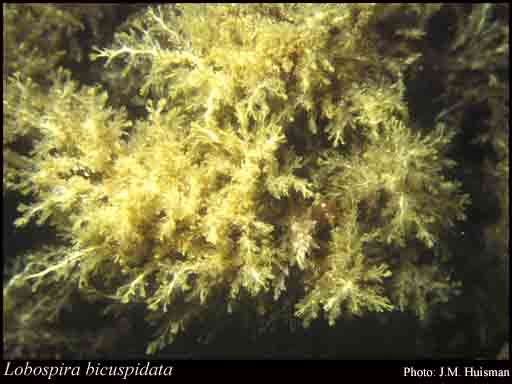- Reference
- Nova Acta Regiae Soc.Sci.Upsal. 364 (1854)
- Conservation Code
- Not threatened
- Naturalised Status
- Native to Western Australia
- Name Status
- Current

Scientific Description
Habit and structure. Thallus medium to dark brown, 5–25 cm long, with numerous, much branched, spirally twisted axes from an entangled base. Axes compressed, becoming subterete below, 0.5–1.5 mm in diameter, with irregularly radial laterals, bearing pointed or bicuspid, compressed, determinate ramuli (0.5–)1–2(–3) mm long and (0.5–)1–1.5(–3) mm broad, 3–5 cells thick, on a phyllotaxis of 1/3, denuded below. Attachment of thallus by long branches with lateral, recurved, tendrils, emitted from lower axes; usually epiphytic. Growth by short rows of cells at the apices of the axes or laterals. Cortical cells of ramuli 20–40 µm across, L/B 1–2. Phaeophycean hair tufts in centre of branchlets, often remaining undeveloped.
Reproduction. Tetrasporangia scattered on ramuli and branches, 80–100(120) µm in diameter, transformed from surface cells and sunken (slightly protruding when dried), dividing into four shortly before their loss. Sexual reproduction unknown.
Distribution. From the Houtman Abrolhos, W. Aust., around southern Australia to Eden, N.S.W.
Habitat. L. bicuspidata is often common just below low tide level and extending to 13 m deep.
[After Womersley, Mar. Benthic Fl. Southern Australia II: 214–216 (1987)]
Distribution
- IBRA Regions
- Esperance Plains, Geraldton Sandplains, Jarrah Forest, Swan Coastal Plain, Warren.
- IBRA Subregions
- Geraldton Hills, Perth, Recherche, Southern Jarrah Forest, Warren.
- IMCRA Regions
- Abrolhos Islands, Central West Coast, Leeuwin-Naturaliste, WA South Coast.
- Local Government Areas (LGAs)
- Augusta Margaret River, Busselton, Cockburn, Dandaragan, Esperance, Greater Geraldton, Irwin, Mandurah, Manjimup, Rockingham, Wanneroo.